2003 FORD F250 jump start
[x] Cancel search: jump startPage 2 of 280

Locks and Security 65
Keys 65
Locks 65
Anti-theft system 67
Seating and Safety Restraints 72
Seating 72
Safety restraints 77
Air bags 90
Child restraints 99
Driving 110
Starting 110
Brakes 115
Transmission operation 118
Trailer towing 146
Roadside Emergencies 174
Getting roadside assistance 174
Hazard flasher switch 175
Fuel pump shut-off switch 175
Fuses and relays 176
Changing tires 181
Jump starting 192
Wrecker towing 197
Customer Assistance 199
Reporting safety defects (U.S. only) 207
Cleaning 208
2003 F250/350/450/550(f23)
Owners Guide (post-2002-fmt)
USA English(fus)
Table of Contents
2
Page 174 of 280
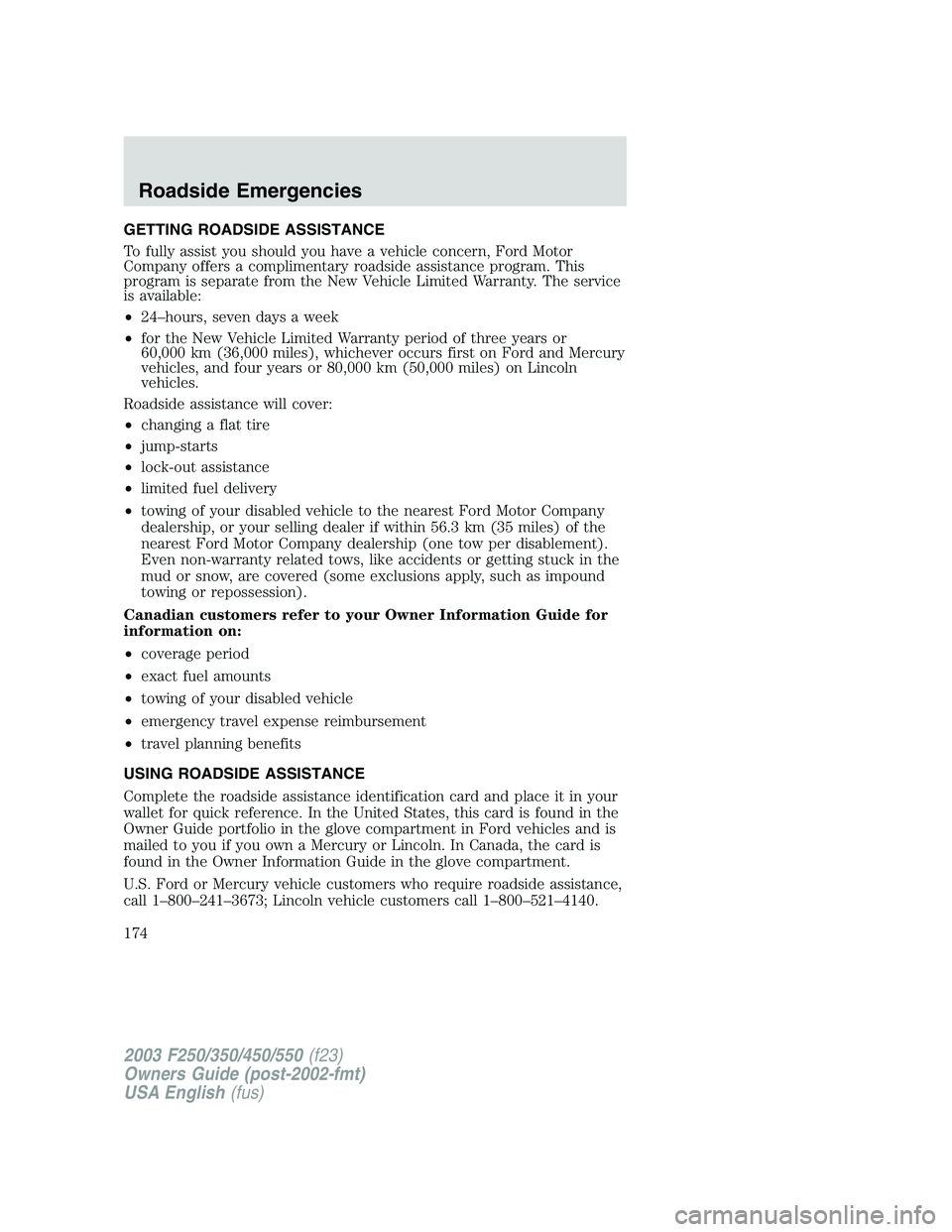
GETTING ROADSIDE ASSISTANCE
To fully assist you should you have a vehicle concern, Ford Motor
Company offers a complimentary roadside assistance program. This
program is separate from the New Vehicle Limited Warranty. The service
is available:
•24–hours, seven days a week
•for the New Vehicle Limited Warranty period of three years or
60,000 km (36,000 miles), whichever occurs first on Ford and Mercury
vehicles, and four years or 80,000 km (50,000 miles) on Lincoln
vehicles.
Roadside assistance will cover:
•changing a flat tire
•jump-starts
•lock-out assistance
•limited fuel delivery
•towing of your disabled vehicle to the nearest Ford Motor Company
dealership, or your selling dealer if within 56.3 km (35 miles) of the
nearest Ford Motor Company dealership (one tow per disablement).
Even non-warranty related tows, like accidents or getting stuck in the
mud or snow, are covered (some exclusions apply, such as impound
towing or repossession).
Canadian customers refer to your Owner Information Guide for
information on:
•coverage period
•exact fuel amounts
•towing of your disabled vehicle
•emergency travel expense reimbursement
•travel planning benefits
USING ROADSIDE ASSISTANCE
Complete the roadside assistance identification card and place it in your
wallet for quick reference. In the United States, this card is found in the
Owner Guide portfolio in the glove compartment in Ford vehicles and is
mailed to you if you own a Mercury or Lincoln. In Canada, the card is
found in the Owner Information Guide in the glove compartment.
U.S. Ford or Mercury vehicle customers who require roadside assistance,
call 1–800–241–3673; Lincoln vehicle customers call 1–800–521–4140.
2003 F250/350/450/550(f23)
Owners Guide (post-2002-fmt)
USA English(fus)
Roadside Emergencies
Roadside Emergencies
174
Page 192 of 280
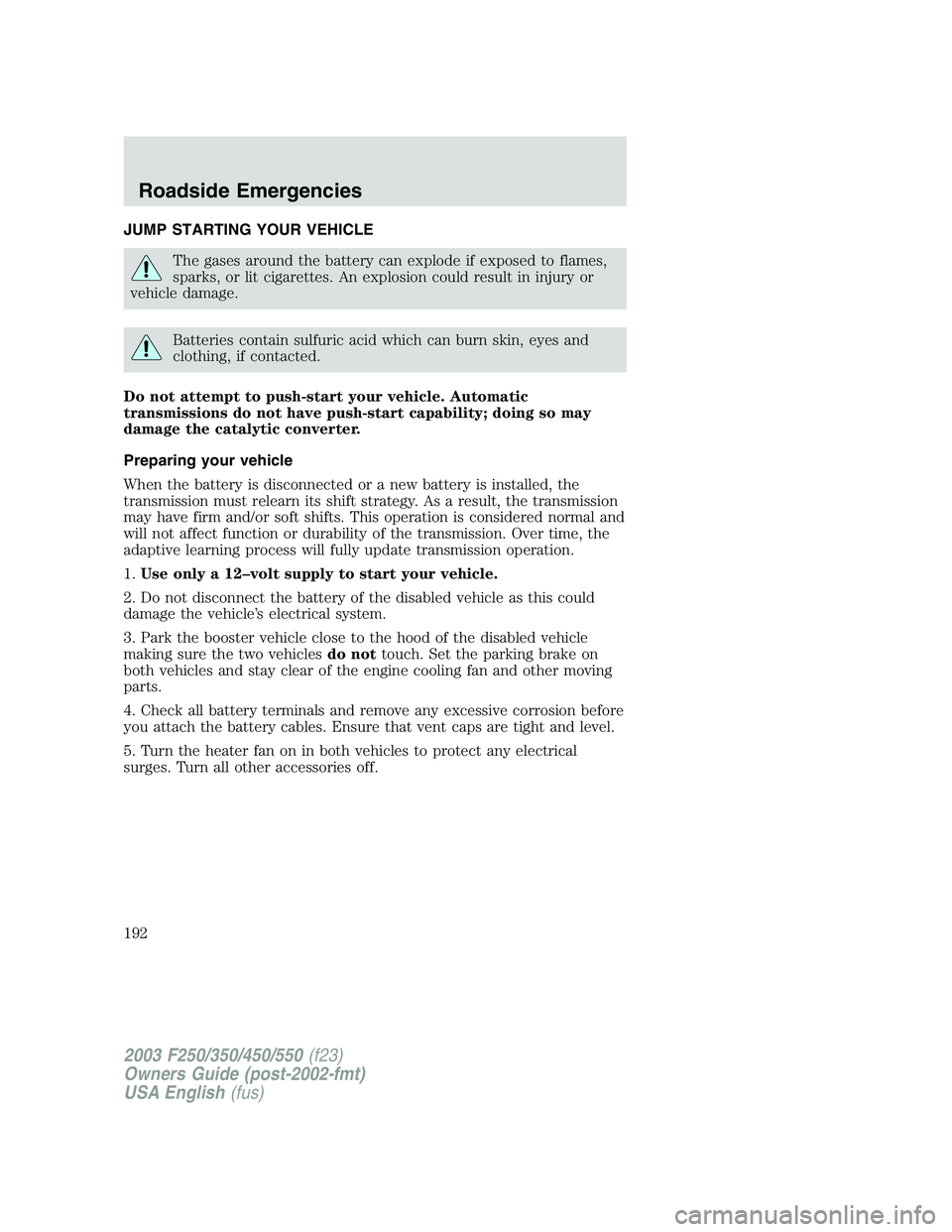
JUMP STARTING YOUR VEHICLE
The gases around the battery can explode if exposed to flames,
sparks, or lit cigarettes. An explosion could result in injury or
vehicle damage.
Batteries contain sulfuric acid which can burn skin, eyes and
clothing, if contacted.
Do not attempt to push-start your vehicle. Automatic
transmissions do not have push-start capability; doing so may
damage the catalytic converter.
Preparing your vehicle
When the battery is disconnected or a new battery is installed, the
transmission must relearn its shift strategy. As a result, the transmission
may have firm and/or soft shifts. This operation is considered normal and
will not affect function or durability of the transmission. Over time, the
adaptive learning process will fully update transmission operation.
1.Use only a 12–volt supply to start your vehicle.
2. Do not disconnect the battery of the disabled vehicle as this could
damage the vehicle’s electrical system.
3. Park the booster vehicle close to the hood of the disabled vehicle
making sure the two vehiclesdo nottouch. Set the parking brake on
both vehicles and stay clear of the engine cooling fan and other moving
parts.
4. Check all battery terminals and remove any excessive corrosion before
you attach the battery cables. Ensure that vent caps are tight and level.
5. Turn the heater fan on in both vehicles to protect any electrical
surges. Turn all other accessories off.
2003 F250/350/450/550(f23)
Owners Guide (post-2002-fmt)
USA English(fus)
Roadside Emergencies
192
Page 194 of 280
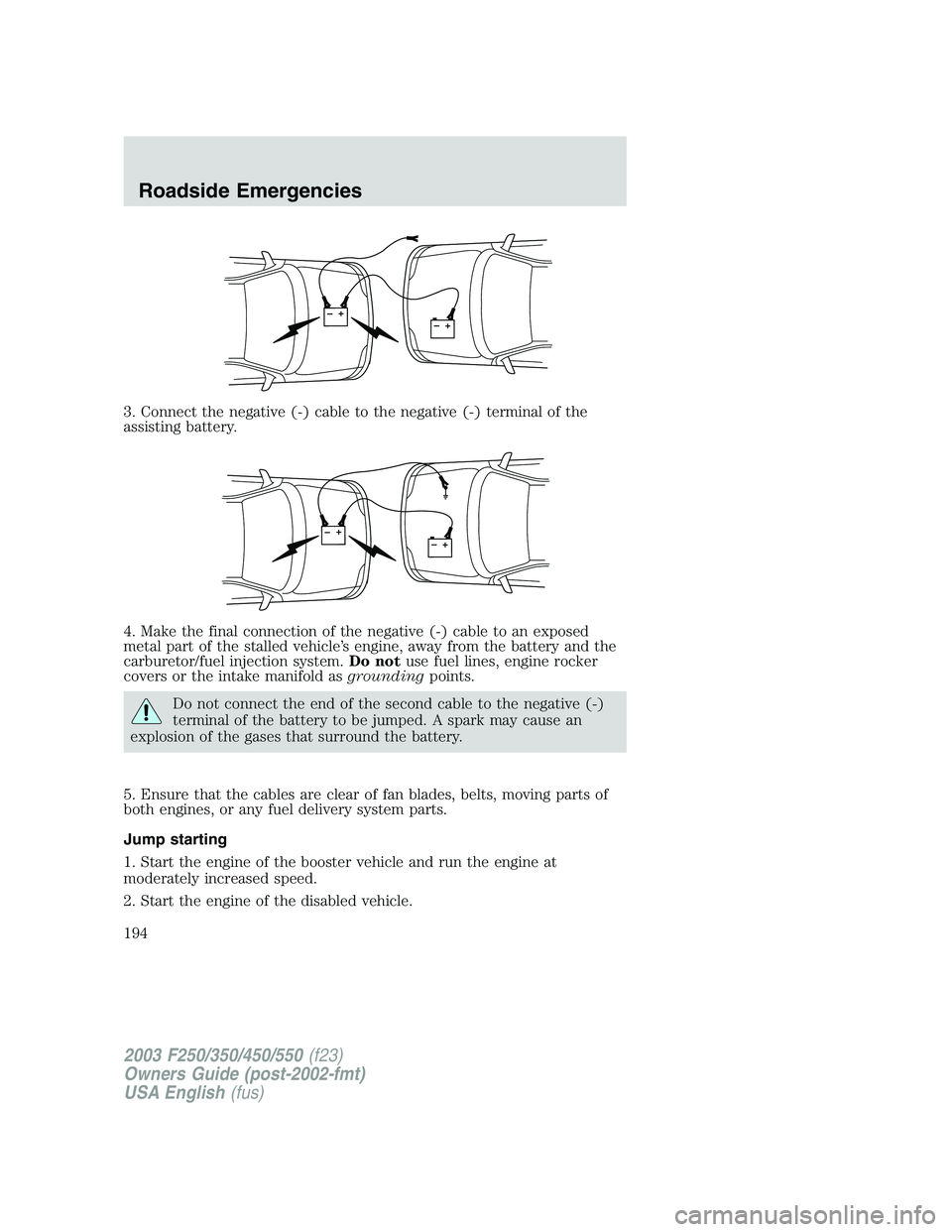
3. Connect the negative (-) cable to the negative (-) terminal of the
assisting battery.
4. Make the final connection of the negative (-) cable to an exposed
metal part of the stalled vehicle’s engine, away from the battery and the
carburetor/fuel injection system.Do notuse fuel lines, engine rocker
covers or the intake manifold asgroundingpoints.
Do not connect the end of the second cable to the negative (-)
terminal of the battery to be jumped. A spark may cause an
explosion of the gases that surround the battery.
5. Ensure that the cables are clear of fan blades, belts, moving parts of
both engines, or any fuel delivery system parts.
Jump starting
1. Start the engine of the booster vehicle and run the engine at
moderately increased speed.
2. Start the engine of the disabled vehicle.
+–+–
+–+–
2003 F250/350/450/550(f23)
Owners Guide (post-2002-fmt)
USA English(fus)
Roadside Emergencies
194
Page 195 of 280
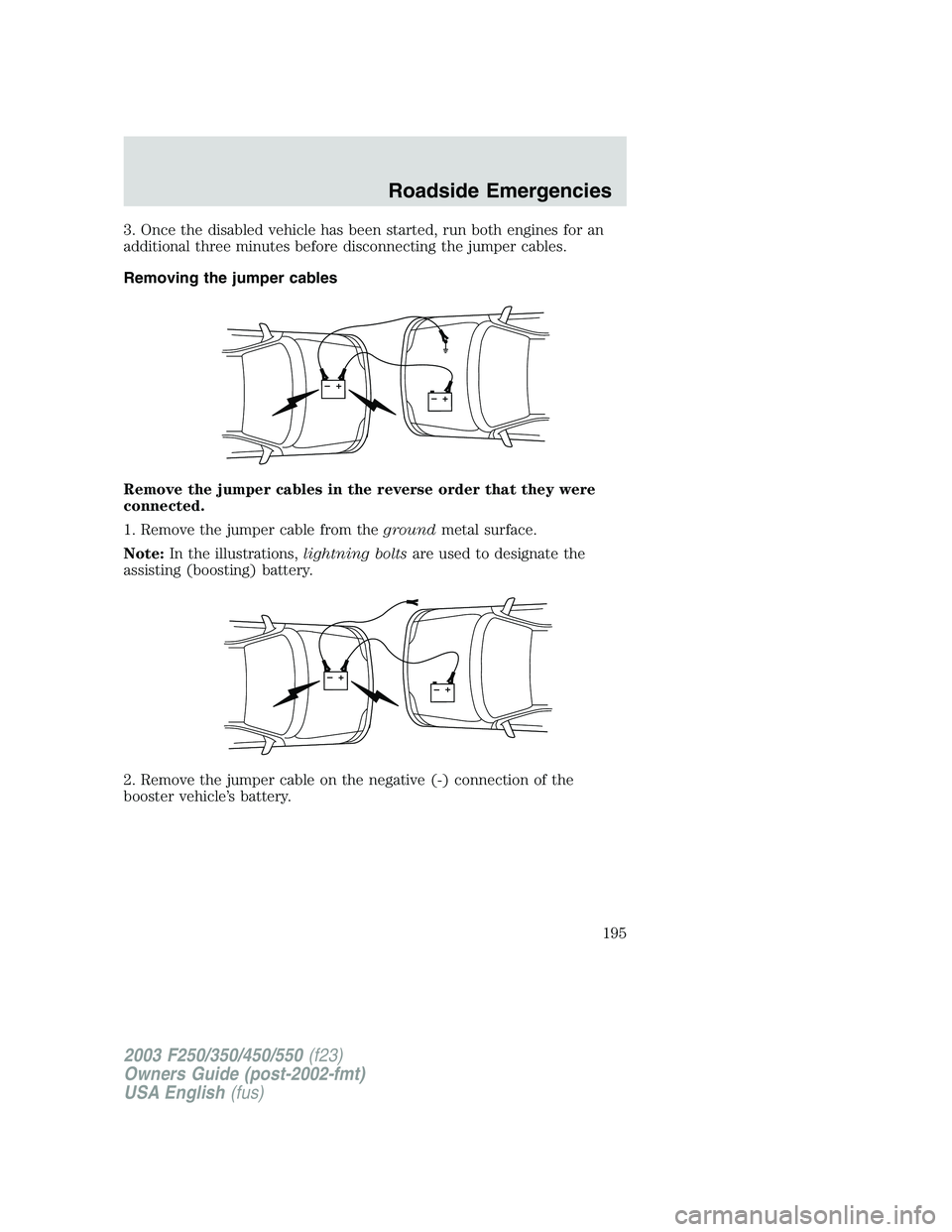
3. Once the disabled vehicle has been started, run both engines for an
additional three minutes before disconnecting the jumper cables.
Removing the jumper cables
Remove the jumper cables in the reverse order that they were
connected.
1. Remove the jumper cable from thegroundmetal surface.
Note:In the illustrations,lightning boltsare used to designate the
assisting (boosting) battery.
2. Remove the jumper cable on the negative (-) connection of the
booster vehicle’s battery.
+–+–
+–+–
2003 F250/350/450/550(f23)
Owners Guide (post-2002-fmt)
USA English(fus)
Roadside Emergencies
195
Page 196 of 280
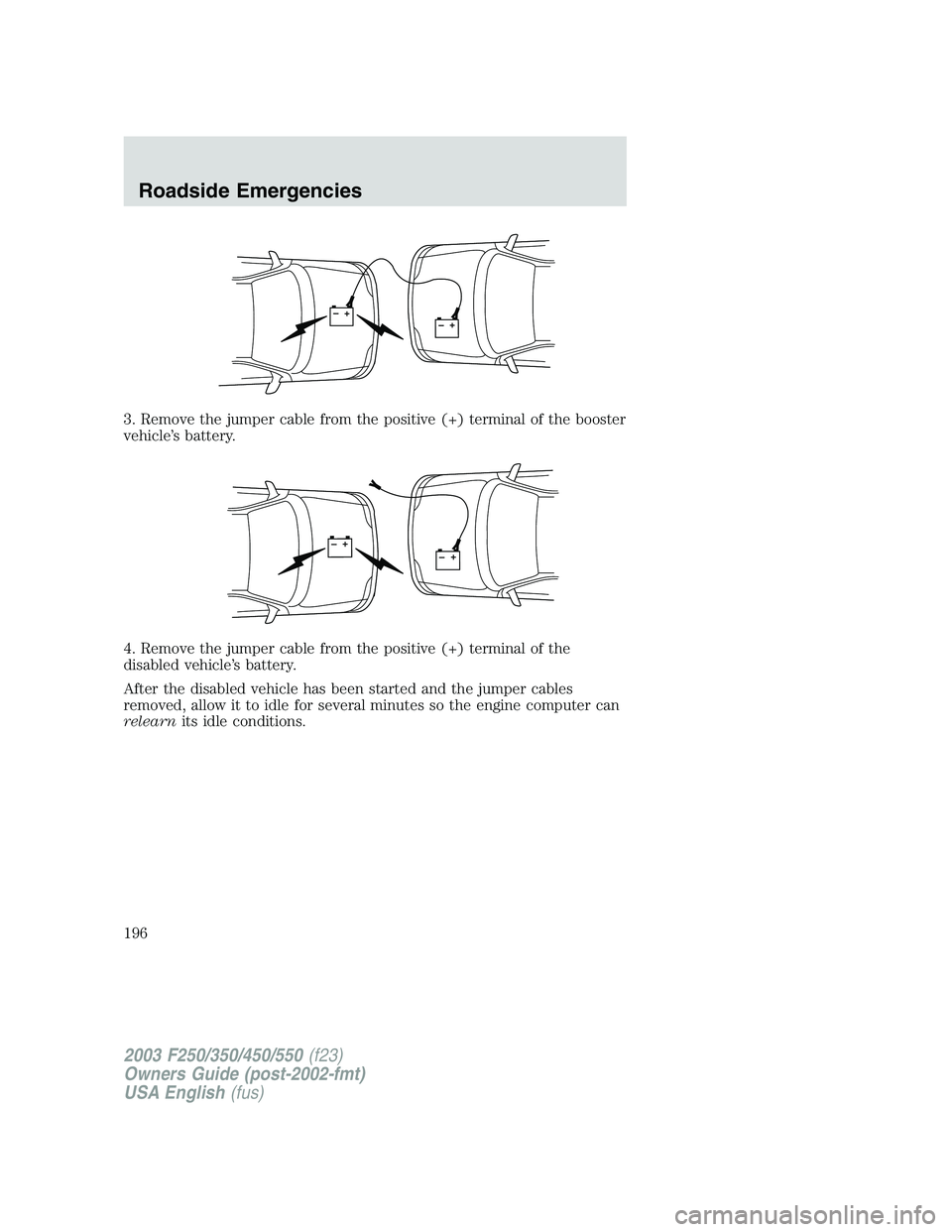
3. Remove the jumper cable from the positive (+) terminal of the booster
vehicle’s battery.
4. Remove the jumper cable from the positive (+) terminal of the
disabled vehicle’s battery.
After the disabled vehicle has been started and the jumper cables
removed, allow it to idle for several minutes so the engine computer can
relearnits idle conditions.
+–+–
+–+–
2003 F250/350/450/550(f23)
Owners Guide (post-2002-fmt)
USA English(fus)
Roadside Emergencies
196
Page 275 of 280
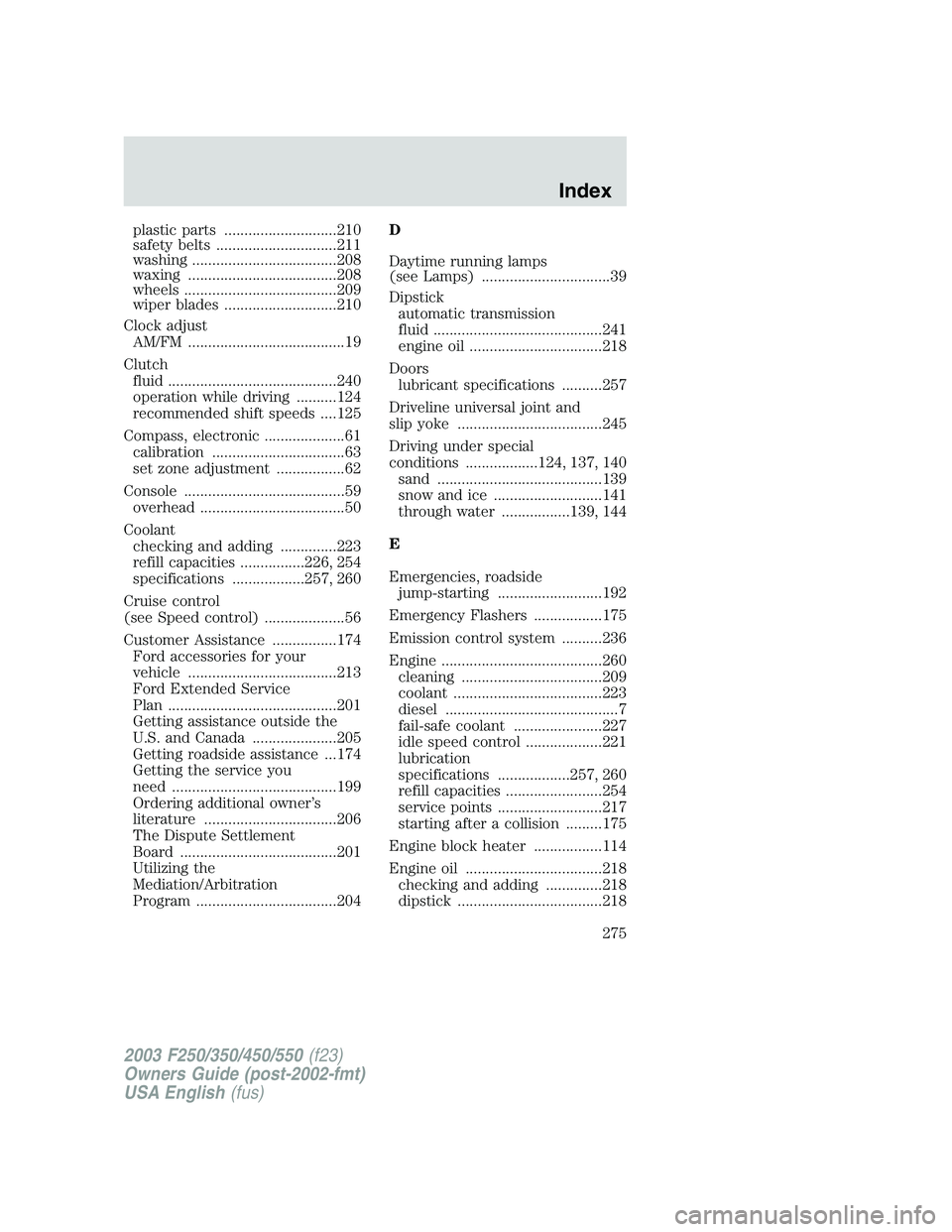
plastic parts ............................210
safety belts ..............................211
washing ....................................208
waxing .....................................208
wheels ......................................209
wiper blades ............................210
Clock adjust
AM/FM .......................................19
Clutch
fluid ..........................................240
operation while driving ..........124
recommended shift speeds ....125
Compass, electronic ....................61
calibration .................................63
set zone adjustment .................62
Console ........................................59
overhead ....................................50
Coolant
checking and adding ..............223
refill capacities ................226, 254
specifications ..................257, 260
Cruise control
(see Speed control) ....................56
Customer Assistance ................174
Ford accessories for your
vehicle .....................................213
Ford Extended Service
Plan ..........................................201
Getting assistance outside the
U.S. and Canada .....................205
Getting roadside assistance ...174
Getting the service you
need .........................................199
Ordering additional owner’s
literature .................................206
The Dispute Settlement
Board .......................................201
Utilizing the
Mediation/Arbitration
Program ...................................204D
Daytime running lamps
(see Lamps) ................................39
Dipstick
automatic transmission
fluid ..........................................241
engine oil .................................218
Doors
lubricant specifications ..........257
Driveline universal joint and
slip yoke ....................................245
Driving under special
conditions ..................124, 137, 140
sand .........................................139
snow and ice ...........................141
through water .................139, 144
E
Emergencies, roadside
jump-starting ..........................192
Emergency Flashers .................175
Emission control system ..........236
Engine ........................................260
cleaning ...................................209
coolant .....................................223
diesel ...........................................7
fail-safe coolant ......................227
idle speed control ...................221
lubrication
specifications ..................257, 260
refill capacities ........................254
service points ..........................217
starting after a collision .........175
Engine block heater .................114
Engine oil ..................................218
checking and adding ..............218
dipstick ....................................218
2003 F250/350/450/550(f23)
Owners Guide (post-2002-fmt)
USA English(fus)
Index
275
Page 277 of 280
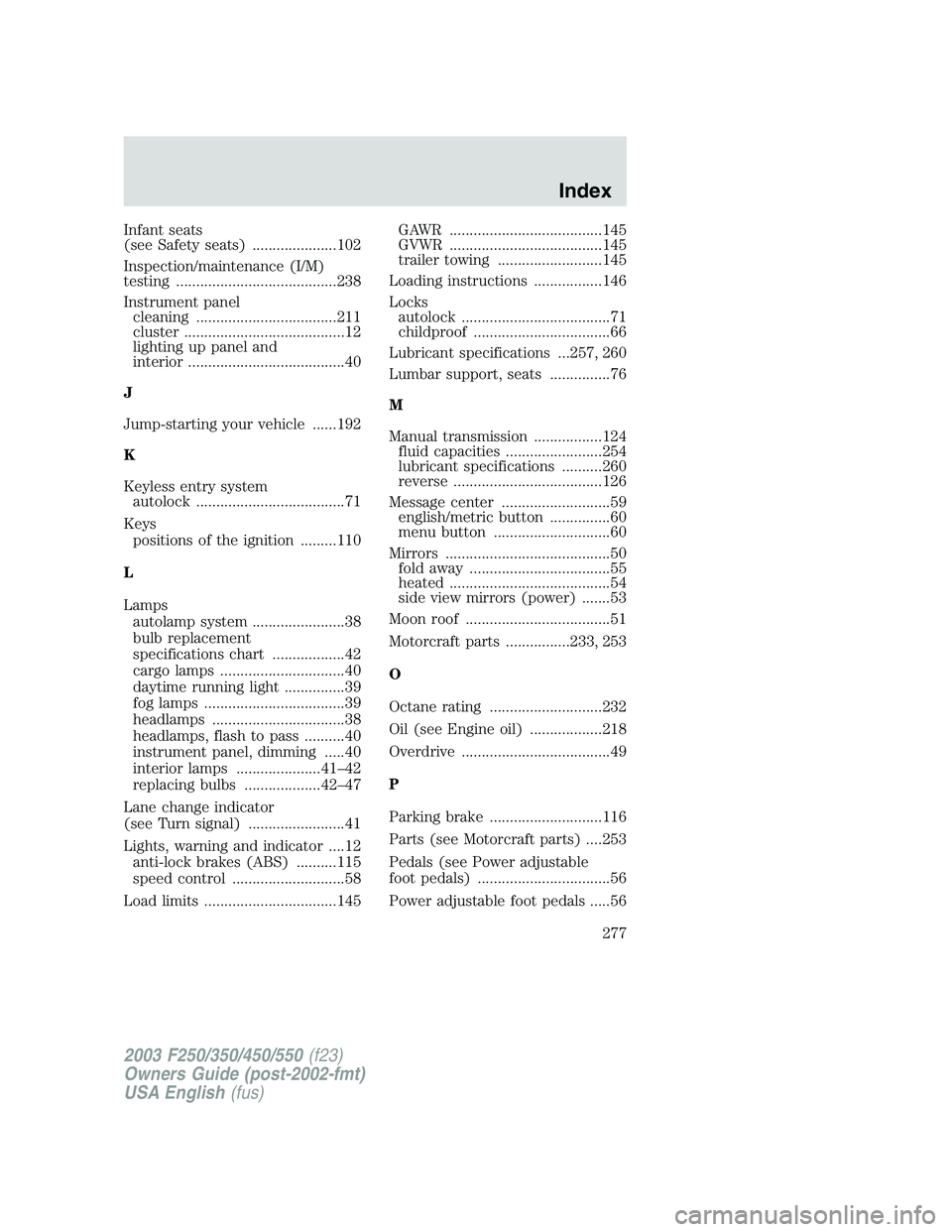
Infant seats
(see Safety seats) .....................102
Inspection/maintenance (I/M)
testing ........................................238
Instrument panel
cleaning ...................................211
cluster ........................................12
lighting up panel and
interior .......................................40
J
Jump-starting your vehicle ......192
K
Keyless entry system
autolock .....................................71
Keys
positions of the ignition .........110
L
Lamps
autolamp system .......................38
bulb replacement
specifications chart ..................42
cargo lamps ...............................40
daytime running light ...............39
fog lamps ...................................39
headlamps .................................38
headlamps, flash to pass ..........40
instrument panel, dimming .....40
interior lamps .....................41–42
replacing bulbs ...................42–47
Lane change indicator
(see Turn signal) ........................41
Lights, warning and indicator ....12
anti-lock brakes (ABS) ..........115
speed control ............................58
Load limits .................................145GAWR ......................................145
GVWR ......................................145
trailer towing ..........................145
Loading instructions .................146
Locks
autolock .....................................71
childproof ..................................66
Lubricant specifications ...257, 260
Lumbar support, seats ...............76
M
Manual transmission .................124
fluid capacities ........................254
lubricant specifications ..........260
reverse .....................................126
Message center ...........................59
english/metric button ...............60
menu button .............................60
Mirrors .........................................50
fold away ...................................55
heated ........................................54
side view mirrors (power) .......53
Moon roof ....................................51
Motorcraft parts ................233, 253
O
Octane rating ............................232
Oil (see Engine oil) ..................218
Overdrive .....................................49
P
Parking brake ............................116
Parts (see Motorcraft parts) ....253
Pedals (see Power adjustable
foot pedals) .................................56
Power adjustable foot pedals .....56
2003 F250/350/450/550(f23)
Owners Guide (post-2002-fmt)
USA English(fus)
Index
277